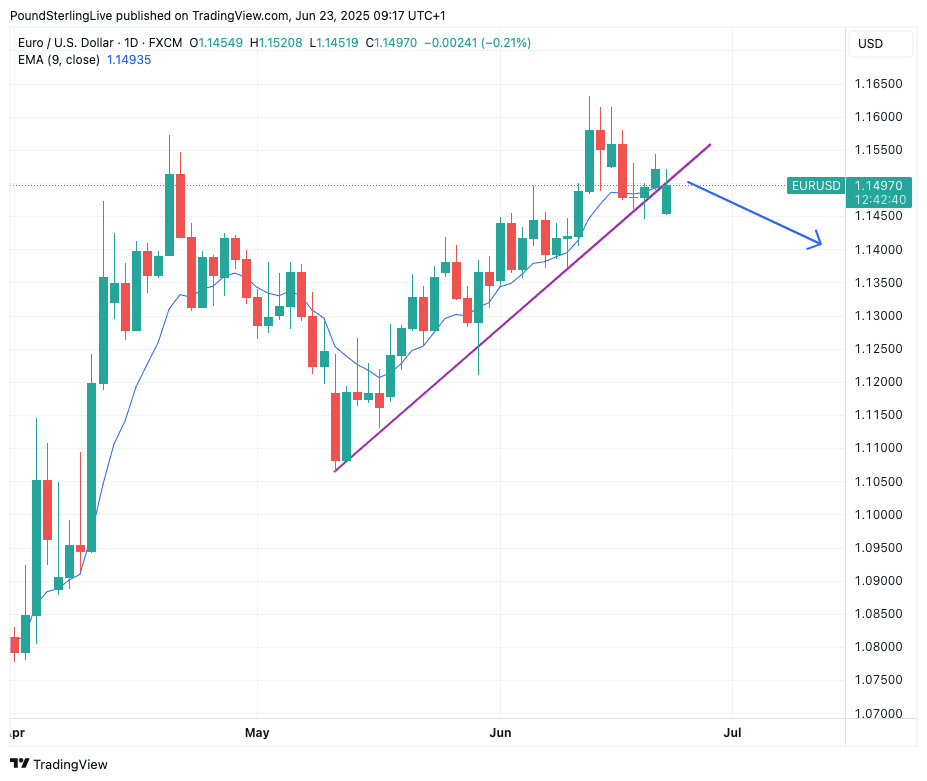Euro-to-Dollar Week Ahead Forecast: The Correction
- Written by: Gary Howes

Image © European Union - European Parliament.
The Euro is correcting lower against the U.S. Dollar.
The Euro to Dollar exchange rate (EUR/USD) is forecast to retain a soft underbelly in the coming week as a wider U.S. Dollar correction takes shape.
As the chart shows, we are now through the uptrend line that underpinned the May-June rally, with the peak at 1.1631 looking to be the exhaustion point. The subsequent lows that have followed that June 12 high are part of a pullback that we forecast to extend over the coming days, and even weeks.
Above: EUR/USD at daily intervals.
The Dollar jumped at the start of trading on Monday, creating a 'gap' lower in Euro-Dollar to 1.1451, thanks to rising tensions in the Middle East, with Iran said to be considering closing the Strait of Hormuz to shipping.
As we note here, such a move would represent a significant positive development for the U.S. Dollar, and underscores the potential for a retracement in Euro-Dollar to below 1.14 in the next five days.
How far the Euro travels against the Dollar will largely rest with Iran's retaliation to the American strike on its nuclear facilities on the weekend.
The closure of the Strait of Hormuz is being considered by leaders in Tehran, although shutting down a fifth of the world's oil supplies risks upsetting close allies, most notably China. It also risks antagonising fellow Gulf states.
It seems markets are still not ready to discount this worst-case outcome, given the implied risks to Iran, which means oil hasn't rocketed and Euro-Dollar hasn't fallen out of bed.
"The initial financial market reaction has been relatively muted," says Lee Hardman, FX strategist at MUFG Bank Ltd.
"The initial muted market response could be a reflection that market participants are waiting to see how Iran will respond to the U.S. military strikes to determine whether the conflict will prove more disruptive for the global economy and financial markets," he adds.
This wait-and-see environment is unlikely to sink the Euro, but it will still be a net support for the USD, and why we would expect Euro-Dollar to enter a short-term downtrend.
More broadly, however, we don't think that this represents the end of the Dollar's decline, and analysts say the fundamentals align for an extension higher in Euro-Dollar to above 1.20 in a bigger multi-month trend.
"Trump’s explosive policy mix (DOGE, tariffs, big beautiful bill) triggered uncertainty on future U.S. economic growth and sustainability of public finances with markets showing a loss of confidence in the dollar," says Marias van der Jeugt, analyst at KBC Bank.
"EUR/USD is in a buy-the-dip pattern on track with a medium-term target at 1.2349. The end to the ECB’s easing cycle and German/European spending plans help the euro part of the equation," he adds.
The new week starts with some good news out of Germany, with the composite PMI - a measure of private sector business activity - expanding in June. The PMI read at 50.4, up from May's 48.5, which beats expectations for another sub-50 reading of 49.
The Eurozone PMI also registered an expansionary 50.2, which is unchanged on June's reading.
These data point to the economy humming along through the mid-point of the year, defying President Trump's tariffs and giving credibility to expectations that the European Central Bank (ECB) can now pause its rate cutting cycle, a development that would be bullish for the Euro.
🇺🇸 United States This Week
The U.S. sees a relatively busy calendar that should also show the economy is defying the worst fears associated with Trump's radical agenda.
Should the data meet expectations, then the USD recovery can extend a little.
📅 Monday, 23 June
📌 Flash PMIs (June, preliminary):
S&P Global Composite PMI: Watch for signals on the overall economy
Services PMI: Previous: 54.8
Manufacturing PMI: Previous: 51.3
🔸 Market Sensitivity:
Analysts at Citi note markets are "overly sensitive" to this data now. Strong readings → USD support as they imply solid demand, inflation persistence.
Weak surprise → Could revive rate cut bets, pressuring USD.
📅 Tuesday, 24 June
📌 New Home Sales (May):
Prior: 634k
Consensus: Expected slight rebound
🔸 Market Sensitivity:
Watch for signs of housing resilience.
Stronger print = continued domestic demand = USD supportive
Weakness may signal softening growth backdrop = USD mildly bearish
📌 Fed Governor Waller speaks at 17:45 BST (12:45 EDT)
🔸 Market Focus:
His views are often closely watched; recent tone has been less dovish
Hawkish lean = supports USD; dovish tilt = pressures USD
📅 Wednesday, 25 June
📌 Durable Goods Orders (May):
Core Orders (ex-aircraft): Key component
Prior headline: +0.6%
🔸 USD Implications:
Another positive print reinforces U.S. growth resilience → USD support
A slowdown or miss would pressure growth expectations → bearish USD
📅 Thursday, 26 June
📌 Q1 GDP (Final):
Previous: +1.3% (2nd est.)
Focus: Revisions to core PCE deflator and consumption
🔸 Market Sensitivity:
Little change expected, but if inflation metrics are revised up → USD positive
Weaker consumption or downward revision → softens USD
📌 Initial Jobless Claims:
Prior: 238k
Recent readings have trended higher
🔸 USD Implications:
Above 250k could flag labour softening = USD negative
A drop back to low 230k = tight labour market = supports USD
📅 Friday, 27 June
📌 Core PCE Price Index (May):
Consensus: +0.1–0.2% MoM
Previous: +0.2% MoM
YoY Core PCE: Expected around 2.6% YoY
🔸 Market Sensitivity:
This is the Federal Reserve’s gauge of inflation, so it matters.
"For the USD to truly make a comeback, US data has to improve and so too does the outlook for fiscal sustainability. U.S. PCE and consumer confidence data will therefore be important," says Valentin Marinov, Head of FX Research at Crédit Agricole.
A hotter-than-expected number → delays rate cuts → USD bullish
A softer print could reignite dovish momentum → USD bearish
📌 Personal Spending & Income (May):
Strong consumption = supports growth narrative = USD positive
Weak data = less pressure on inflation = USD negative
📌 University of Michigan Final Consumer Sentiment (June):
Includes inflation expectations
🔸 USD Implications:
Stable expectations = limited impact. Sharp shifts in the inflation outlook could influence USD short-term





